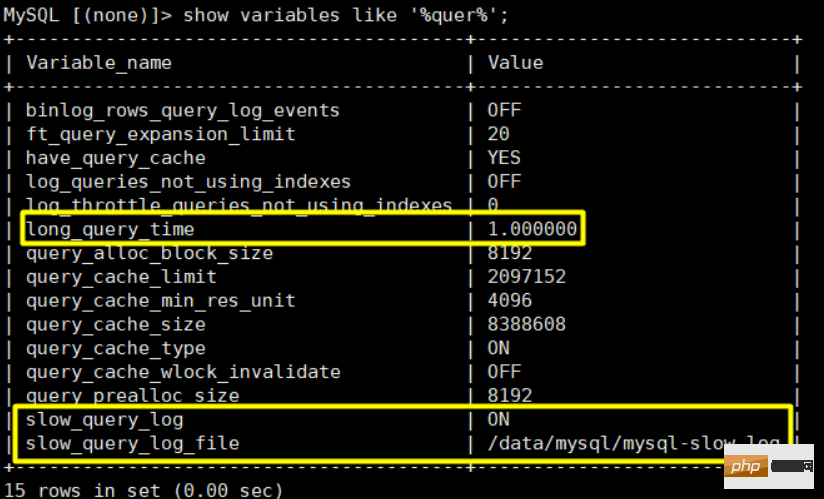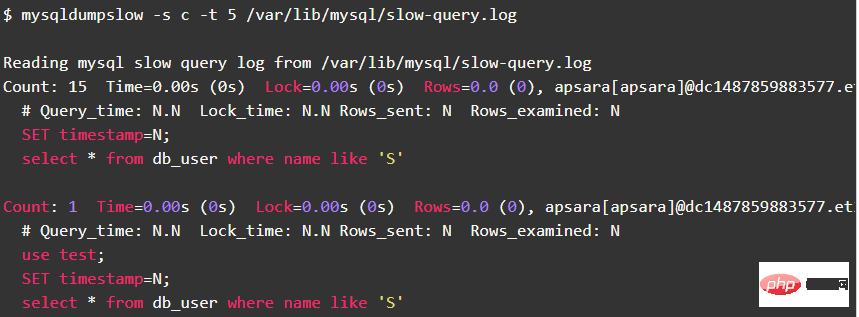show variables like 'log_output';
mysqldumpslow
MySQL slow query log practice (graphic and text analysis)
Recommended learning: mysql video tutorial
1. Overview
MySQL’s slow query log is provided by MySQL A kind of log record, which is used to record SQL statements whose response time exceeds the threshold (long_query_time, unit: seconds) in MySQL. By default, MySQL does not start slow query logging. This article briefly introduces how to enable slow query logs and how to use mysqldumpslow to analyze slow queries.
2. Slow query log settings
1. Temporary settings
Temporarily enable the slow query log (failed after restarting)
set global slow_query_log = on;

Note: If you want to turn off the slow query log, you only need to execute set global slow_query_log = off;.
Temporary slow query time critical point Query times higher than this critical point will be recorded in the slow query log (restart failure)
set long_query_time = 1;

Set slow Query storage method (invalid after restart)
set global log_output = file;

Explanation: As you can see, I set it to file here, which means that my slow query log is It is reflected by file. The default is none. We can set it to table or file. If it is table, the slow query information will be saved to the slow_log table under the mysql library.
2. Query the opening status of the slow query log and the storage location of the slow query log
show variables like '%quer%';

##Parameter description:
- slow_query_log: Whether slow query has been enabled
- slow_query_log_file: Slow query log file path
- long_query_time: Queries that exceed the number of seconds are written to the log
show variables like 'log_output';
Copy after login
show variables like 'log_output';

[mysqld]slow_query_log= 1slow_query_log_file= /var/lib/mysql/slow-query.log # 若没有指定,默认名字为hostname_slow.loglong_query_time= 1log_queries_not_using_indexes= 1
Create a slow query and execute it. As follows:
mysql> select sleep(1);+----------+ | sleep(1) | +----------+ | 0 | +----------+ 1 row in set (1.00 sec)

mysqldumpslow
Copy after login
mysqldumpslow is MySQL’s own tool for analyzing slow queries. The tool is a Perl script. mysqldumpslow
Commonly used parameters are as follows:
- -s: Sort method, the value is as follows
- c: Number of queries
- t:Query time
- l:Lock time
- r:Return records
- ac:Average number of queries
- al:Average lock time
- ar:Average return record book
- at:Average query time
- -t:topN query
- -g :Regular expression
Get the 5 most visited SQL statements:

$ mysqldumpslow -s t -t 5 /var/lib/mysql/slow-query.log
$ mysqldumpslow -s t -t 3 -g "like" /var/lib/mysql/slow-query.log
五、MySQL 清理slowlog方法
SET GLOBAL slow_query_log = 'OFF'; ALTER TABLEmysql.slow_log RENAME mysql.slow_log_drop; CREATE TABLE mysql.slow_log LIKEmysql.slow_log_drop; SET GLOBAL slow_query_log = 'ON'; DROP TABLE mysql.slow_log_drop;
推荐学习:mysql视频教程
The above is the detailed content of MySQL slow query log practice (graphic and text analysis). For more information, please follow other related articles on the PHP Chinese website!

Hot AI Tools

Undresser.AI Undress
AI-powered app for creating realistic nude photos

AI Clothes Remover
Online AI tool for removing clothes from photos.

Undress AI Tool
Undress images for free

Clothoff.io
AI clothes remover

AI Hentai Generator
Generate AI Hentai for free.

Hot Article

Hot Tools

Notepad++7.3.1
Easy-to-use and free code editor

SublimeText3 Chinese version
Chinese version, very easy to use

Zend Studio 13.0.1
Powerful PHP integrated development environment

Dreamweaver CS6
Visual web development tools

SublimeText3 Mac version
God-level code editing software (SublimeText3)

Hot Topics
 1384
1384
 52
52
 MySQL: Simple Concepts for Easy Learning
Apr 10, 2025 am 09:29 AM
MySQL: Simple Concepts for Easy Learning
Apr 10, 2025 am 09:29 AM
MySQL is an open source relational database management system. 1) Create database and tables: Use the CREATEDATABASE and CREATETABLE commands. 2) Basic operations: INSERT, UPDATE, DELETE and SELECT. 3) Advanced operations: JOIN, subquery and transaction processing. 4) Debugging skills: Check syntax, data type and permissions. 5) Optimization suggestions: Use indexes, avoid SELECT* and use transactions.
 How to open phpmyadmin
Apr 10, 2025 pm 10:51 PM
How to open phpmyadmin
Apr 10, 2025 pm 10:51 PM
You can open phpMyAdmin through the following steps: 1. Log in to the website control panel; 2. Find and click the phpMyAdmin icon; 3. Enter MySQL credentials; 4. Click "Login".
 MySQL: An Introduction to the World's Most Popular Database
Apr 12, 2025 am 12:18 AM
MySQL: An Introduction to the World's Most Popular Database
Apr 12, 2025 am 12:18 AM
MySQL is an open source relational database management system, mainly used to store and retrieve data quickly and reliably. Its working principle includes client requests, query resolution, execution of queries and return results. Examples of usage include creating tables, inserting and querying data, and advanced features such as JOIN operations. Common errors involve SQL syntax, data types, and permissions, and optimization suggestions include the use of indexes, optimized queries, and partitioning of tables.
 Why Use MySQL? Benefits and Advantages
Apr 12, 2025 am 12:17 AM
Why Use MySQL? Benefits and Advantages
Apr 12, 2025 am 12:17 AM
MySQL is chosen for its performance, reliability, ease of use, and community support. 1.MySQL provides efficient data storage and retrieval functions, supporting multiple data types and advanced query operations. 2. Adopt client-server architecture and multiple storage engines to support transaction and query optimization. 3. Easy to use, supports a variety of operating systems and programming languages. 4. Have strong community support and provide rich resources and solutions.
 How to use single threaded redis
Apr 10, 2025 pm 07:12 PM
How to use single threaded redis
Apr 10, 2025 pm 07:12 PM
Redis uses a single threaded architecture to provide high performance, simplicity, and consistency. It utilizes I/O multiplexing, event loops, non-blocking I/O, and shared memory to improve concurrency, but with limitations of concurrency limitations, single point of failure, and unsuitable for write-intensive workloads.
 MySQL and SQL: Essential Skills for Developers
Apr 10, 2025 am 09:30 AM
MySQL and SQL: Essential Skills for Developers
Apr 10, 2025 am 09:30 AM
MySQL and SQL are essential skills for developers. 1.MySQL is an open source relational database management system, and SQL is the standard language used to manage and operate databases. 2.MySQL supports multiple storage engines through efficient data storage and retrieval functions, and SQL completes complex data operations through simple statements. 3. Examples of usage include basic queries and advanced queries, such as filtering and sorting by condition. 4. Common errors include syntax errors and performance issues, which can be optimized by checking SQL statements and using EXPLAIN commands. 5. Performance optimization techniques include using indexes, avoiding full table scanning, optimizing JOIN operations and improving code readability.
 MySQL's Place: Databases and Programming
Apr 13, 2025 am 12:18 AM
MySQL's Place: Databases and Programming
Apr 13, 2025 am 12:18 AM
MySQL's position in databases and programming is very important. It is an open source relational database management system that is widely used in various application scenarios. 1) MySQL provides efficient data storage, organization and retrieval functions, supporting Web, mobile and enterprise-level systems. 2) It uses a client-server architecture, supports multiple storage engines and index optimization. 3) Basic usages include creating tables and inserting data, and advanced usages involve multi-table JOINs and complex queries. 4) Frequently asked questions such as SQL syntax errors and performance issues can be debugged through the EXPLAIN command and slow query log. 5) Performance optimization methods include rational use of indexes, optimized query and use of caches. Best practices include using transactions and PreparedStatemen
 How to build a SQL database
Apr 09, 2025 pm 04:24 PM
How to build a SQL database
Apr 09, 2025 pm 04:24 PM
Building an SQL database involves 10 steps: selecting DBMS; installing DBMS; creating a database; creating a table; inserting data; retrieving data; updating data; deleting data; managing users; backing up the database.





